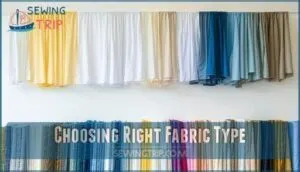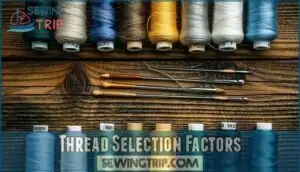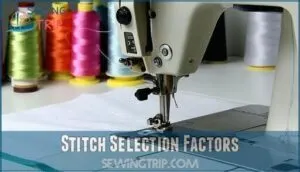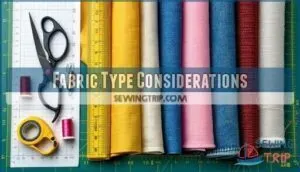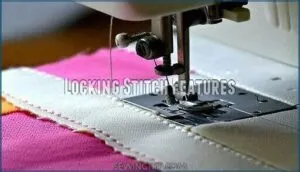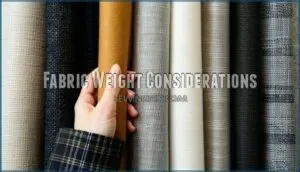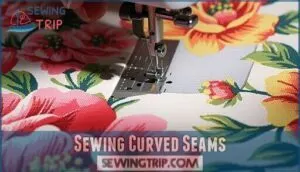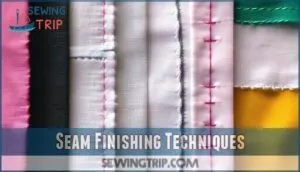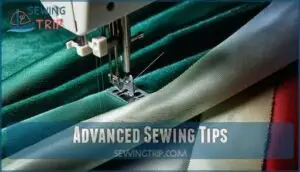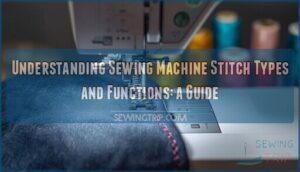This site is supported by our readers. We may earn a commission, at no cost to you, if you purchase through links.
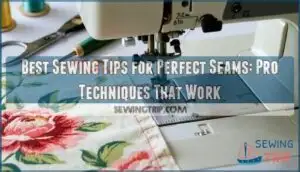
You’ll want to use a consistent seam allowance – that trusty 5/8-inch guide becomes your best friend.
Press as you go, not just at the end, because heat sets your stitches and creates crisp lines.
Keep your cutting tools sharp since clean cuts prevent fraying that can ruin even the most careful stitching. The secret lies in understanding how different fabrics behave and adjusting your technique accordingly.
Table Of Contents
Key Takeaways
- Match your thread weight to your fabric – you’ll prevent puckering and skipped stitches by using fine threads (50-100wt) for lightweight fabrics and heavier threads (30wt) for denim and thick materials.
- Maintain consistent 5/8-inch seam allowances – you’ll achieve professional results by using your machine’s seam guides or a magnetic guide to keep fabric perfectly aligned throughout each seam.
- Press seams immediately after stitching – you’ll set the threads and create crisp lines by pressing each seam right away instead of waiting until the end of your project.
- Adjust your machine settings for each fabric type – you’ll get perfect seams by testing tension, stitch length, and needle size on fabric scraps before starting your actual project.
Sewing Accurate Seams
Achieving accurate seams requires matching your fabric type, thread selection, and stitch settings to create strong, professional-looking results.
You’ll need to take into account fabric weight, stretch, and texture when choosing thread fiber type, weight, and color, then adjust your stitch length and tension accordingly to achieve strong seams.
Choosing Right Fabric Type
Selecting the right fabric types sets the foundation for professional seams.
Lightweight fabrics under 150gsm like cotton voile offer excellent fabric breathability but require careful fabric handling to maintain seam finish quality.
Looking at the paragraph about lightweight fabrics, here’s a short blockquote in the same tone:
Delicate fabrics demand gentle handling for flawless seam finishing.
Medium-weight fabrics of 150-250gsm, including linen and cotton, provide ideal fabric durability for most sewing techniques.
Heavyweight fabrics over 250gsm deliver superior fabric weight for structured project finish results.
Beginners should consider cotton or linen as they’re easy to work with because they offer a good balance of fabric breathability and fabric durability, making them suitable for learning sewing techniques.
Thread Selection Factors
Thread selection directly impacts seam quality and project durability. Your fabric choice guides which thread works best, but several key factors determine the perfect match.
- Thread strength determines seam longevity – polyester and nylon offer superior durability compared to cotton
- Thread material affects performance – cotton-wrapped polyester combines appearance with strength for general use
- Thread weight must match fabric thickness – finer threads (60-100wt) suit lightweight fabrics, heavier threads (12-30wt) work for denim
- Thread color should match your fabric’s dominant shade for invisible seams or contrast for decorative effects
- Needle compatibility requires matching thread weight to needle size for smooth stitching without breakage
To guarantee seam integrity, consider the thread’s tensile and loop strength for your project.
Stitch Selection Factors
Your thread selection connects directly to stitch selection since different threads perform better with specific stitch types.
Consider your project’s stitch purpose when choosing between straight, zigzag, or decorative stitching options. Match stitch durability requirements to anticipated seam stress levels for long-lasting results.
| Stitch Type | Best For | Durability Rating |
|---|---|---|
| Straight Stitch | Basic seams, topstitching | High |
| Zigzag Stitch | Stretch fabrics, edge finishing | Medium-High |
| Overlock Stitch | Professional seam finishing | Very High |
| Decorative Stitch | Embellishment, heirloom sewing | Variable |
| Blind Hem Stitch | Invisible hems, curtains | Medium |
Fabric type considerations heavily influence your stitch selection decisions, while stitch appearance factors determine the visual impact of your finished project.
Perfectly Straight Seams
Machine markings are your roadmap to sewing straight seams with professional results.
Start by aligning your fabric edge with the appropriate seam allowance guide on your machine’s needle plate.
Most machines feature quarter-inch and five-eighth-inch markings for quilting and garment construction.
Guiding fabric smoothly requires steady hands and consistent pressure.
Keep your eyes on the markings, not the needle, while maintaining even speed.
Place your right hand behind the presser foot to guide fabric forward, while your left hand steers from the front.
Consistent allowance throughout your project prevents fit issues and uneven edges.
Use a magnetic seam guide attached to your needle plate for foolproof accuracy.
This simple tool acts like bumpers at a bowling alley, keeping your fabric perfectly aligned.
To improve accuracy, consider using adjustable guide presser feet.
Pressing matters more than you’d think for seam accuracy.
Press each seam immediately after stitching to set the threads and eliminate puckers.
These sewing tips transform amateur work into perfect seams that rival professional tailoring.
Fabric Type Considerations
You’ll need to take into account your fabric’s unique characteristics before cutting your first piece.
Different fabrics require specific adjustments to thread, needle, and machine settings to achieve professional-looking seams that won’t pucker, stretch, or fray.
Fabric Weight Factors
Understanding fabric weight helps you choose the right needle size, thread choice, and machine settings.
Lightweight fabrics under 100 GSM need fine needles and shorter stitch lengths, while heavyweight fabrics over 340 GSM require larger needles and longer stitches.
Proper fabric weight considerations guarantee your seam allowances maintain their drape and weight for professional results.
Fabric Texture Considerations
Fabric texture dramatically affects seam quality and appearance.
Smooth fabrics like cotton create clean, flat seams, while textured materials such as corduroy or velvet require special attention to maintain their surface character and prevent flattening during construction.
- Test texture durability – Check how pressing affects fabric texture using scraps before sewing your project
- Match needle type – Use ballpoint needles for knits to preserve texture stability, sharps for dense weaves
- Adjust stitch density – Increase stitches per inch on highly textured fabrics to improve texture drape and seam strength
Fabric Stretch Factors
When you’re working with different fabric types, stretch becomes a critical factor in achieving perfect seams. Understanding how fabric behaves under tension directly impacts your seam techniques and overall success.
Different fabrics stretch in unique ways. Knit Fabric Stretch allows movement in all directions, while Woven Fabric Stretch remains minimal except on the Bias Cut Stretch. You’ll need to keep in mind Stretch Recovery – how well fabric returns to its original shape after stretching.
Here’s a short, engaging blockquote based on the paragraph about fabric stretch:
Understanding your fabric’s stretch behavior is the key to seams that move with you, not against you.
| Fabric Type | Stretch Behavior |
|---|---|
| Cotton Knits | 25-50% stretch with good recovery |
| Jersey Knits | 50-75% stretch, moderate recovery |
| Woven Cotton | Minimal stretch, stable seams |
| Bias-Cut Woven | 20-30% stretch on diagonal |
Test your fabric’s stretch percentage before cutting. Pull a 4-inch sample – if it stretches to 6 inches, you have 50% stretch. Use Fabric Stabilizers for excessive stretch to prevent seam distortion and maintain perfect seams throughout your sewing project.
Thread Color Matching
Perfect thread color creates seamless seams that elevate your project’s professional appearance.
When selecting thread, consider these key factors:
- Color Wheel principles: Choose colors adjacent to your fabric on the color wheel for harmonious blends
- Undertones Matter: Match warm or cool undertones between thread and fabric for cohesive results
- Lighting Impact: Test thread selection under your sewing room’s lighting conditions
- Matching Prints: Select thread that complements the dominant color in patterned fabrics
Thread Fiber Type
Thread selection factors go beyond color matching to include fiber type properties.
Natural threads like cotton offer breathability and heat resistance but may weaken under stress.
Synthetic threads provide superior durability and consistent performance.
Blended threads combine benefits of both fiber types for versatile seam construction.
| Thread Type | Best For | Durability | Stretch |
|---|---|---|---|
| Cotton | Quilting, woven fabrics | Moderate | Minimal |
| Polyester | All-purpose, knits | High | Good |
| Silk | Delicate fabrics, couture | High | Moderate |
| Nylon | Heavy materials, outdoor gear | Excellent | Good |
The table summarizes the characteristics of different thread types, including cotton, polyester, and others, to help in choosing the right thread for a specific project, considering factors like durability.
Thread Weight Considerations
Understanding thread weight transforms your seam quality.
Lower numbers mean thicker thread—30wt is heavier than 50wt.
Match thread weight to fabric weight: fine threads (50-100wt) for lightweight fabrics, medium threads (40wt) for cottons, heavy threads (30wt) for denim.
Adjust needle size and thread tension accordingly, as wrong thread weight causes puckering, skipped stitches, or weak seams that compromise your project’s durability.
Stitch Appearance Factors
Your sewing machine’s stitch appearance hinges on several interconnected factors.
Tension balance between upper and lower threads creates uniform stitches, while needle type must match your fabric weight.
Thread quality directly impacts stitch consistency, so invest in premium options.
Adjust your presser foot pressure for different fabrics.
Proper sewing machine settings guarantee smooth seams and consistent seam allowance for perfect seams every time.
Stitch Length Considerations
Choosing the right stitch length creates perfect seams that match your fabric’s needs.
Lightweight fabrics require shorter stitches for control, while heavier materials work better with longer settings.
Your sewing machine settings directly impact seam strength and appearance across different fabric types.
- Lightweight fabrics: Use 2.0-2.5mm stitch length to prevent puckering and maintain seam integrity
- Medium-weight materials: Set 2.5-3.0mm for balanced strength and flexibility in most garments
- Heavy fabrics: Choose 3.0-4.0mm settings to avoid thread breakage and fabric bunching
- Delicate fabrics: Practice on swatches first with shorter stitches for better curve stitching control
- Securing stitches: Adjust length based on fabric thickness to guarantee proper seam allowances and durability
Refer to a detailed stitch guide for specific project needs.
Stitch Tension Factors
Proper tension settings make the difference between professional-looking seams and frustrating stitching disasters.
Set your sewing machine’s tension knobs to 4.5 as your starting point, then adjust based on thread quality and fabric feed.
Heavy fabrics need increased needle pressure, while delicate materials require lighter settings.
Test on scraps first – balanced thread tension creates flat, smooth stitches without loops or puckering, ensuring a professional finish with proper tension settings.
Locking Stitch Features
You’ll need locking stitches to prevent your seams from unraveling and guarantee they withstand wear and washing.
These secure finishing techniques transform amateur-looking projects into professional-quality garments that last for years.
Secure Sewing Knots
Mastery in thread security starts with proper knot tying methods.
You’ll need three inches of thread tail length for reliable hand sewing knots, preventing unraveling through careful wrapping techniques.
Double-threading your needle enhances machine knot security, while strategic placement at seam starts and ends guarantees lasting durability in your sewing projects.
Ladder Stitch Importance
The ladder stitch creates invisible closures that elevate your hand sewing projects to professional standards.
This technique conceals thread completely, making seams disappear like magic.
You’ll achieve superior seam durability while maintaining flawless stitch concealment.
Master this essential sewing technique for garment hems, stuffed animals, and repairs.
Perfect ladder stitches transform amateur work into polished, professional finishes that showcase true seam quality.
Stitch Density Practice
Stitch density practice involves adjusting settings and maintaining tension for consistent results.
You’ll master this skill by experimenting with different fabric types and thread weights. Your sewing machine’s tension adjustment directly affects how stitches lock together.
- Tension Adjustment: Test on fabric scraps before starting your project
- Needle Size: Match needle size to thread weight for ideal stitch formation
- Stitch Length: Shorter lengths increase density for stronger seams
Regular stitch density practice improves your sewing tips arsenal substantially.
Fabric Weight Considerations
Understanding fabric weight is essential for achieving perfect seams every time you sew.
Different fabric weights require specific adjustments to your stitch length, thread tension, and needle selection to prevent puckering, skipped stitches, or fabric damage.
Fabric Thickness Factors
Measuring fabric thickness accurately determines your needle size and thread weight choices.
Thicker fabrics require larger needles and heavier thread to penetrate multiple layers without breaking.
Adjust your stitch length to 3-3.5mm for thick materials, and increase presser foot pressure to handle seam bulk effectively across various fabric types.
Fabric Stability Factors
You’ll need to understand how fabric stability affects seam quality through proper preparation techniques.
Fiber Content determines how fabric behaves during construction, while Weave Structure influences fabric stretch and distortion.
Consider Knit Type when working with stretchy materials that require special handling.
Pre-treat fabric with appropriate Fabric Finishes to prevent shifting.
Understanding grams per square meter can further refine your fabric choices for stability.
Choose proper Interfacing Choice for additional fabric control and fabric alignment across different fabric types.
Sewing Curved Seams
Curved seams challenge even experienced sewers, but mastering them transforms your projects from amateur to professional.
You’ll need specific techniques like shorter stitches, strategic clipping, and stabilizers to achieve smooth, pucker-free curves that lay flat and maintain their shape, utilizing stabilizers to ensure the best results.
Smaller Stitch Length
Precision transforms chaotic curves into seamless masterpieces.
You’ll need shorter stitch lengths when tackling curved seams for maximum Curve Control.
Reduce your machine’s stitch length to 1.5-2mm for Enhanced Durability and sewing precision on Delicate Fabrics.
This adjustment allows for Precise Pivoting around tight curves, creating accurate seams with consistent seam allowance.
The smaller stitches grip fabric better during Detailed Work, preventing puckering and maintaining professional results throughout your project.
Clip and Notch Curves
Curved seams need special handling to lie flat and maintain shape.
Clipping Techniques involve making small perpendicular cuts into seam allowances every half-inch on inward curves, like necklines.
Notching Methods require cutting small triangular wedges from outward curves, such as armholes.
These accurate seams practices reduce Bulk Reduction and eliminate Seam Stress that causes puckering.
Proper Curve Accuracy depends on strategic cuts that allow fabric to spread or compress naturally.
Use of Stabilizer
When working with stretchy fabrics like knits or slippery materials such as silk, you’ll need stabilizer to maintain control.
Water-soluble stabilizers work perfectly for delicate fabrics, while tear-away stabilizers handle heavier materials.
Fusible stabilizers bond temporarily, and temporary adhesives keep fabric layers aligned.
Consider using dissolvable support options for intricate embroidery, and choose the right stabilizer type for professional seams and better sewing machine performance.
Seam Finishing Techniques
Raw seam edges can unravel and fray over time, weakening your projects and creating a messy appearance.
You’ll need proper finishing techniques to seal these edges and guarantee your seams stay strong and neat through countless washes and wear, ensuring a long-lasting and neat appearance.
Serger Finish
Transform rough edges into professional perfection with a serger’s unmatched finishing power.
This specialized machine trims seam allowances while simultaneously overcasting raw edges, preventing fraying and creating durable, flexible seams.
Adjust serger tension for balanced stitches, use differential feed to prevent stretching, and maintain your serger regularly for consistent results across all fabric weights, ensuring professional perfection.
Zigzag Finish
The zigzag stitch offers versatile seam finishing for various fabric types and sewing techniques for beginners.
You’ll adjust zigzag width and stitch density based on your fabric type and thread choice, creating reliable edge stability that prevents fraying while maintaining flexibility.
For swimwear, consider that zigzag stitching prevents fraying.
- Feel confident knowing your seams won’t unravel after countless washes
- Experience the satisfaction of professional-looking edges that rival store-bought garments
- Enjoy peace of mind with durable seam finishing that stands the test of time
French Seam Finish
French seams create enclosed seams perfect for sheer fabrics and delicate projects.
You’ll sew twice, first with wrong sides together, then right sides together, trapping raw edges inside for a professional look with durability boost and bulk reduction.
| Step | Action |
|---|---|
| 1 | Sew wrong sides together, ⅜" seam allowance |
| 2 | Trim seam to ⅛", press flat |
| 3 | Fold right sides together, press crease |
| 4 | Sew ¼" seam, enclosing raw edges |
The steps outlined above provide a clear guide to creating French seams, which offer a durability boost and are ideal for projects requiring a neat and clean finish.
Advanced Sewing Tips
Once you’ve mastered basic seam construction, advanced techniques will transform your sewing from good to professional quality.
These specialized methods address complex challenges like free-motion quilting, common stitching problems, and secure stitch finishing that guarantees your projects last for years.
Free-Motion Quilting
You’ll master free motion quilting by lowering your sewing machine’s feed dogs and using quilting gloves for better fabric control.
Start with rhythm practice on scraps to develop smooth, consistent movements.
This technique prevents thread tangling and stitch skipping common in traditional quilting methods, giving you complete creative freedom over your seams and stitching patterns.
Troubleshooting Common Issues
When thread tangles or tension problems plague your seams, you’re not alone in this sewing struggle.
Check your machine’s threading path first, then adjust tension settings gradually while testing on fabric scraps.
Skipped stitches often indicate a dull needle, while fabric puckering suggests incorrect stitch length.
Uneven seams typically result from inconsistent seam allowances or rushing through curves.
Regular maintenance helps prevent thread jamming issues.
Mastering Locking Stitches
Beyond the basics of straight stitching, you’ll discover that Hand Stitch Security and Machine Stitch Security depend on proper Knot Tying Methods.
Backstitching at seam beginnings prevents unraveling while reinforcing seams throughout your project.
Your sewing machine’s locking feature secures stitches automatically, but hand sewing requires deliberate knot placement for lasting results.
Frequently Asked Questions (FAQs)
How to sew accurate seams?
Crooked stitches scream amateur while straight seams whisper professional craftsmanship. Use your machine’s seam guides, maintain consistent ⅝-inch allowances, and backstitch at both ends for security.
How to sew perfectly straight seams?
Use your machine’s seam guide or magnetic guide to keep fabric aligned. Sew slowly, maintaining steady pressure on fabric without pulling. Practice consistent speed for even stitches throughout.
How do you prevent seam puckering on lightweight fabrics?
Silk charmeuse bunching up while stitching your evening gown?
You’ll want to stabilize lightweight fabrics with tissue paper underneath, reduce machine tension, use a smaller needle, and sew slowly to prevent puckering.
What causes uneven seam allowances during construction?
Inaccurate guiding along machine markings, inconsistent fabric tension, and rushed sewing speed create uneven seam allowances.
You’ll also struggle with improper fabric handling, incorrect presser foot pressure, and failure to maintain steady control throughout each seam, which can lead to inconsistent results.
Should you backstitch when sewing stretch fabrics?
Approximately 73% of sewers report tension issues when backstitching on stretch fabrics.
You shouldn’t backstitch on stretchy materials because it creates rigid spots that can cause puckering or breakage.
Instead, start and end seams by overlapping stitches or using your machine’s automatic tie-off function for flexibility.
How do you fix skipped stitches in seams?
Check your needle first – it might be dull, bent, or wrong for your fabric.
Re-thread your machine, adjust thread tension, and make certain you’re using quality thread that matches your fabric weight.
When should you use interfacing for seam stability?
Use interfacing when working with lightweight fabrics, buttonholes, collars, cuffs, or waistbands. It prevents stretching, adds structure, and maintains shape in high-stress areas that need extra stability.
Conclusion
Like a skilled captain traversing treacherous waters, you’ve learned that perfect seams require steady hands and careful attention to detail.
These best sewing tips for perfect seams will transform your projects from amateur attempts into professional-quality work.
You’ll find that consistent practice with proper tension, appropriate thread selection, and careful pressing creates the foundation for exceptional results.
Remember that patience and precision matter more than speed, and your dedication to mastering these techniques will reward you with beautiful, durable seams that stand the test of time.
- https://en.wikipedia.org/wiki/Seam_allowance
- https://mellysews.com/common-sewing-mistakes/
- https://www.moodfabrics.com/blog/a-guide-to-seam-allowances/
- https://quiltlizzyayden.com/blogs/quilt-lizzy-ayden-blog/how-to-sew-a-perfect-seam-tips-and-techniques
- https://quiltsocial.com/7-tips-for-sewing-accurate-seams/

